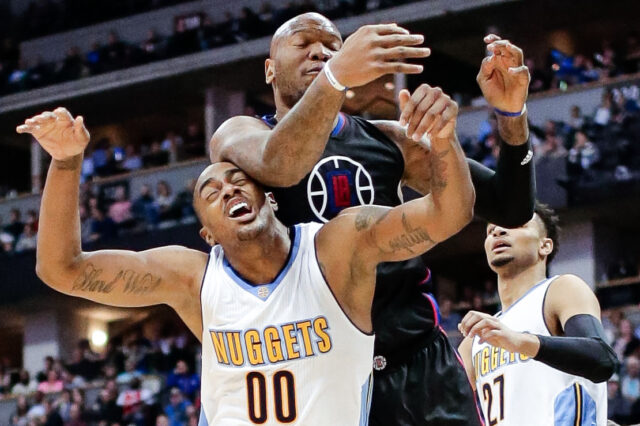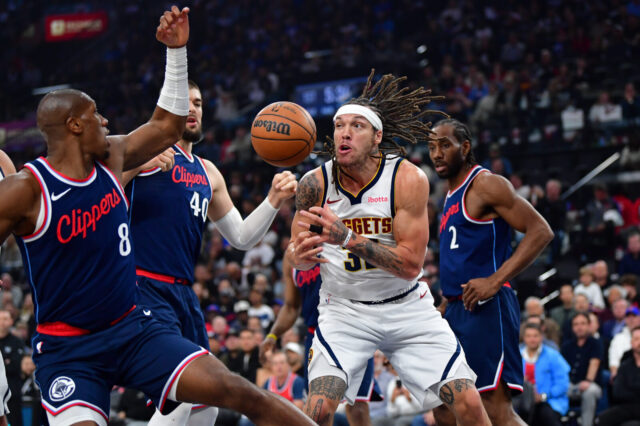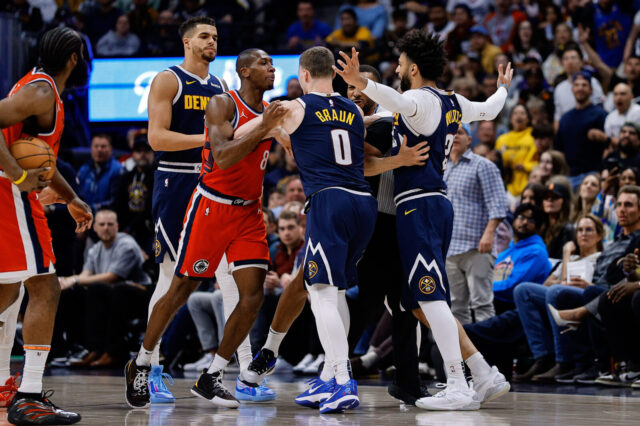Strengths
- Frontcourt offensive versatility
- Three-point shooting
- Offensive Rebounding
Weaknesses
- Perimeter defense
- Rim protection
- Guard playmaking pressure without Jamal Murray
The Denver Nuggets are basically done with free agency at this point. With 15 full-time roster spots currently taken by 15 full-time contracts, it appears that the Nuggets are set with the players they are about to take to training camp in late September. Scarily enough, that’s under two months away from now, and I think everyone could still use a vacation after the extensive number of events over the past several months (regular season, playoffs, draft, free agency, and now summer league). The only moves that should be expected at this point are the two remaining two-way contracts to be filled with players following the events of Las Vegas summer league.
Now, however, is a good time to step back and discuss Denver’s roster as a whole. Many teams are now almost entirely finished with their offseason to-do list, and it doesn’t appear that any earth shattering moves will be happening between now and beginning of the 2021-22 season. That means that the Nuggets can begin to evaluate their roster against other rosters around the NBA, especially among the Western Conference elite, to see how they stack up. What are Denver’s strengths? Weaknesses? How will they fare utilizing those strengths and weaknesses against opposing teams?
Here are my initial thoughts:
Strengths
Offensive versatility in the frontcourt
Denver’s biggest strength clearly centers around their two best healthy players, Nikola Jokić and Michael Porter Jr., and their respective abilities to bend defenses in different ways. Jokić utilizes his versatile inside-out attack as a playmaker for himself and others. Passing out of the post, at the top of the key, at each elbow, and on the move are some of his exploits, and that allows for other players to become involved in unique ways. Porter’s outside jumper sets up the rest of his game well, forcing opponents to shadow him around the court. Give him a bit of breathing room and he has zero qualms with shooting any jumper from any angle, meaning he can be successful coming off screens, utilizing dribble handoffs, and keeping defenses honest with back cuts. Jokić is often more than happy to oblige.
With Jokić’s ability to dribble, pass, and shoot from anywhere on the floor, the next step involves Porter accomplishing much of the same thing. At 6’10” with athleticism for days, Porter has an opportunity to truly expand his overall game if he can become a better playmaker off the dribble for himself and others. Having two players 6’10” and above that can be used in such ways offer Denver unlimited versatility.
Add in different pieces to surround Jokić and Porter offensively and it becomes easy to see how Denver will manipulate defenses. There’s a strong cutter, rebounder, and transition threat with playmaking upside in Aaron Gordon. There’s a steady 3&D power forward in JaMychal Green. There’s a versatile wing/forward in Jeff Green. There’s a 6’11” sweet shooting big man in Zeke Nnaji. Denver can go small with three guards and push Porter to power forward next to Jokić. There are plenty of options to accentuate strengths.
Who will this be most successful against: All average to bad teams, DAL, UTA, LAC
Three-point shooting
The Nuggets finished eighth in the NBA in three-point shooting percentage last year at 37.7%. For much of the year, they were in the top five and fell out due to Jamal Murray’s injury, who was soon joined by Will Barton and Monte Morris as well. The strength of their shooting came from Porter (44.5%) though, and he will be given a green light in the upcoming season to test his limits as a shooter. Add in Jokić (38.8%), Barton (38.1%), and Morris (38.1%) and Denver’s starters should still be fine spacing the floor even without Murray for a significant chunk of the year.
Off the bench will be Facundo Campazzo (35.2% in his first NBA season), Austin Rivers (37.5%), P.J. Dozier (31.5% but some clear shooting upside), JaMychal Green (39.9%) and Jeff Green (41.2% with the Nets). In addition, Bones Hyland (39.9% career college three-point shooter) and Zeke Nnaji (40.7%) figure to have roles at some point as well.
There’s reason to believe the Nuggets upgraded their shooting this offseason and will be a strong shooting team next year. Every player, even Aaron Gordon and Dozier, is capable of hitting outside jumpers. As long as Denver’s shooters maintain confidence and aggression throughout the season, there’s no reason to believe the Nuggets can’t be a great shooting team next year.
Who will this be most successful against: All average to bad teams, UTA, LAL, POR
Offensive rebounding
Highlighted in Denver’s frontcourt versatility is their ability to put pressure on the rim in several ways, and this pressure shows up most consistently in offensive rebounding. The Nuggets generated the second highest offensive rebounding rate in the NBA last regular season and third highest in the playoffs. Jokić is the player most responsible with how he warps the geometry of defenses with his playmaking and skill, but JaMychal Green was also a focal point in Denver’s offensive rebounding.
With Denver returning with a smaller team this year that will forgo a traditional backup center, it’s possible that Denver will recede as an offensive rebounding threat; however, as long as Jokić, Porter, and Gordon remain in the starting lineup, the Nuggets will likely have an advantage against other starting units.
Who will this be most successful against: Smaller teams like POR, GSW, LAC, DAL, etc.
Weaknesses
Perimeter defense
The Nuggets faltered in the playoffs last year due to subpar perimeter defense. With Jamal Murray and P.J. Dozier sidelined, a significant amount of offensive and defensive pressure was placed on Monte Morris, Facundo Campazzo, Austin Rivers, and others. Denver struggled defending the two teams they faced for a number of reasons, including the pressure placed on Porter as a defender on switches, weak side coverages, and scramble situations.
In order to become an elite team once again, the Nuggets will have to find better, more sustainable ways to guard opposing perimeter players. With Jokić already operated as a player who can’t switch onto perimeter players consistently, the Nuggets can’t also have Porter operating in the same mold. He must be able to use his length, athleticism, and mobility to guard on switches, at least at a higher level than he has demonstrated so far. There’s reason to believe he can do better, and however much he improves, along with the rest of Denver’s improvements, may determine if Denver has a championship ceiling or not.
Who will they be most vulnerable against: Elite guard teams like PHX, POR, GSW, UTA, etc.
Rim Protection
Combined with Denver’s perimeter defense concerns are rim protection concerns that have plagued the Nuggets for a long time. Though Jokić has certainly improved as a defender with his ability to play positional defense at center, disrupt passing lanes, and rebound well, the act of saving other teammates and protecting the rim is still not within his skill set. Among all players to defend at least 300 shots within six feet of the rim, Jokić’s DFG% allowed was the third highest in the NBA. To be clear, field goal percentage allowed (DFG%) isn’t the only way to measure rim protection, but it stands to reason that Jokić is still a minus in that regard when opponents are presented with an opportunity
Perhaps the Nuggets will simply forgo rim protection this year. Without a traditional backup center, it’s difficult to see where the rim protection comes from on this roster. Porter averaged 0.9 blocks per game last season, and perhaps he has a new level he can reach as a backline defender. Maybe Bol Bol or Zeke Nnaji will ultimately develop as backup center options and provide some rim protection. At this point though, rim protection is a certifiable weakness for this Nuggets roster.
Who will they be most vulnerable against: All teams with size advantage like LAL, MIL, NOP
Dribble Creation without Jamal Murray
What ultimately led to Denver’s downfall in the playoffs was not having enough offensive counters against the Suns. Jamal Murray was often that catalyst for Denver’s success against Phoenix in prior matchups because of Murray’s ability to score off the dribble and put pressure on Deandre Ayton to make choices guarding Denver’s two-man game. This would involve Murray escaping from his initial defender using screens back cuts, and dribble moves, and then utilizing the threat of Jokić to put Ayton in a bind. Without Murray’s dynamic three-level scoring, the Nuggets didn’t have enough players who could move past step one and escape from their initial defender.
Monte Morris struggled to create space for himself against Chris Paul and Mikal Bridges. Austin Rivers less of a two-man game option and more of an isolation specialist. Facundo Campazzo wasn’t an off the dribble scorer in the slightest. When Will Barton returned, Denver’s offense improved a little due to Barton’s aggressiveness and willingness to pull up from three-point range, but it wasn’t enough to have just one player capable of hitting those shots with regularity.
The Nuggets need Porter to take a step in this regard. As mentioned in the strengths section for offensive versatility, eliminating this weakness will be what ultimately takes Porter from elite shooter to elite player. The Nuggets will need him to shoulder more responsibility next season, and he clearly has the talent and capability to do more. How far along he improves will make a great deal of difference in whether Denver’s offense will be good enough to become less concerned with defensive weaknesses. If Porter takes his offensive game to another level, there will be hell to pay for opposing defenses in a playoff setting.
Who will they be most vulnerable against: Strong team defenses like PHX, GSW, PHI, UTA


